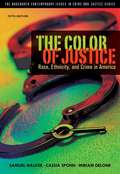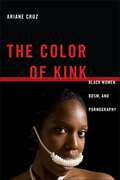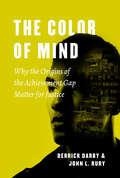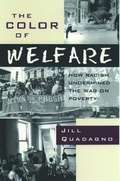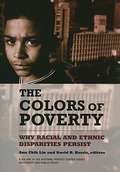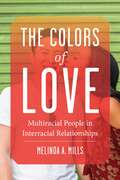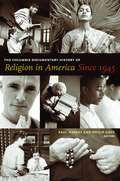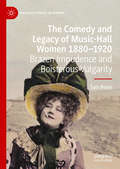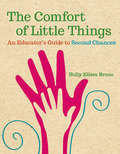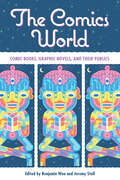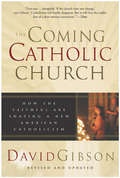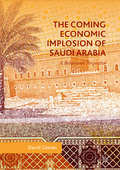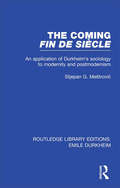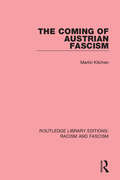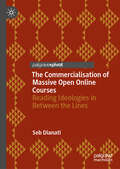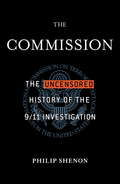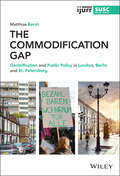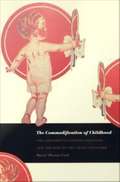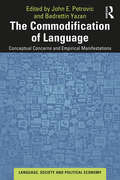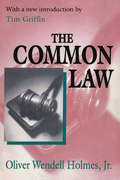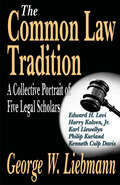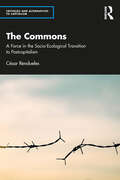- Table View
- List View
The Color Of Justice: Race, Ethnicity, And Crime In America
by Samuel Walker Cassia Spohn Miriam DeloneComprehensive and balanced, THE COLOR OF JUSTICE is the definitive book on current research and theories of racial and ethnic discrimination within America's Criminal Justice system. The best and the most recent research on patterns of criminal behavior and victimization, police practices, court processing and sentencing, the death penalty, and correctional programs are covered giving students the facts and theoretical foundation they need to make their own informed decisions about discrimination in the system. Uniquely unbiased, THE COLOR OF JUSTICE makes every effort to incorporate discussion of all major race groups found in the United States
The Color of Kink: Black Women, BDSM, and Pornography (Families, Law, and Society #26)
by Ariane CruzA study of how BDSM can be used as a metaphor for exploring black female sexuality. The Color of Kink explores black women's representations and performances within American pornography and BDSM (bondage and discipline, domination and submission, and sadism and masochism) from the 1930s to the present, revealing the ways in which they illustrate a complex and contradictory negotiation of pain, pleasure, and power for black women. Based on personal interviews conducted with pornography performers, producers, and professional dominatrices, visual and textual analysis, and extensive archival research, Ariane Cruz reveals BDSM and pornography as critical sites from which to rethink the formative links between Black female sexuality and violence. She explores how violence becomes not just a vehicle of pleasure but also a mode of accessing and contesting power. Drawing on feminist and queer theory, critical race theory, and media studies, Cruz argues that BDSM is a productive space from which to consider the complexity and diverseness of black women's sexual practice and the mutability of black female sexuality. Illuminating the cross-pollination of black sexuality and BDSM, The Color of Kink makes a unique contribution to the growing scholarship on racialized sexuality. Winner of the MLA&’s 2016 Alan Bray Prize for Best Book in LGBTQ Studies
The Color of Mind: Why the Origins of the Achievement Gap Matter for Justice (History and Philosophy of Education Series)
by Derrick Darby John L. Rury“An indispensable text for understanding educational racial injustice and contributing to initiatives to mitigate it.” —Educational TheoryAmerican students vary in educational achievement, but white students in general typically have better test scores and grades than black students. Why is this the case, and what can school leaders do about it? In The Color of Mind, Derrick Darby and John L. Rury answer these pressing questions and show that we cannot make further progress in closing the achievement gap until we understand its racist origins.Telling the story of what they call the Color of Mind—the idea that there are racial differences in intelligence, character, and behavior—they show how philosophers, such as David Hume and Immanuel Kant, and American statesman Thomas Jefferson, contributed to the construction of this pernicious idea, how it influenced the nature of schooling and student achievement, and how voices of dissent such as Frederick Douglass, Frances Ellen Watkins Harper, and W.E.B. Du Bois debunked the Color of Mind and worked to undo its adverse impacts.Rejecting the view that racial differences in educational achievement are a product of innate or cultural differences, Darby and Rury uncover the historical interplay between ideas about race and American schooling, to show clearly that the racial achievement gap has been socially and institutionally constructed. School leaders striving to bring justice and dignity to American schools today must work to root out the systemic manifestations of these ideas within schools, while still doing what they can to mitigate the negative effects of poverty, segregation, inequality, and other external factors that adversely affect student achievement. While we can’t expect schools alone to solve these vexing social problems, we must demand that they address the injustices associated with how we track, discipline, and deal with special education that reinforce long-standing racist ideas. That is the only way to expel the Color of Mind from schools, close the racial achievement gap, and afford all children the dignity they deserve.
The Color of Welfare: How Racism Undermined the War on Poverty
by Jill S. QuadagnoThirty years after Lyndon Johnson declared a War on Poverty, the United States still lags behind most Western democracies in national welfare systems, lacking such basic programs as national health insurance and child care support. Some critics have explained the failure of social programs by citing our tradition of individual freedom and libertarian values, while others point to weaknesses within the working class. In The Color of Welfare, Jill Quadagno takes exception to these claims, placing race at the center of the "American Dilemma," as Swedish economist Gunnar Myrdal did half a century ago. The "American creed" of liberty, justice, and equality clashed with a history of active racial discrimination, says Quadagno. It is racism that has undermined the War on Poverty, and America must come to terms with this history if there is to be any hope of addressing welfare reform today. From Reconstruction to Lyndon Johnson and beyond, Quadagno reveals how American social policy has continually foundered on issues of race. Drawing on extensive primary research, Quadagno shows, for instance, how Roosevelt, in need of support from southern congressmen, excluded African Americans from the core programs of the Social Security Act. Turning to Lyndon Johnson's "unconditional war on poverty," she contends that though anti-poverty programs for job training, community action, health care, housing, and education have accomplished much, they have not been fully realized because they became inextricably intertwined with the civil rights movement of the 1960s, which triggered a white backlash. Job training programs, for instance, became affirmative action programs, programs to improve housing became programs to integrate housing, programs that began as community action to upgrade the quality of life in the cities were taken over by local civil rights groups. This shift of emphasis eventually alienated white, working-class Americans, who had some of the same needs--for health care, subsidized housing, and job training opportunities--but who got very little from these programs. At the same time, affirmative action clashed openly with organized labor, and equal housing raised protests from the white suburban middle-class, who didn't want their neighborhoods integrated. Quadagno shows that Nixon, who initially supported many of Johnson's programs, eventually caught on that the white middle class was disenchanted. He realized that his grand plan for welfare reform, the Family Assistance Plan, threatened to undermine wages in the South and alienate the Republican party's new constituency--white, southern Democrats--and therefore dropped it. In the 1960s, the United States embarked on a journey to resolve the "American dilemma." Yet instead of finally instituting full democratic rights for all its citizens, the policies enacted in that turbulent decade failed dismally. The Color of Welfare reveals the root cause of this failure--the inability to address racial inequality.
The Colors Of Poverty: Why Racial And Ethnic Disparities Exist
by Ann Chih Lin David R. HarrisGiven the increasing diversity of the nation--particularly with respect to its growing Hispanic and Asian populations--why does racial and ethnic difference so often lead to disadvantage? In The Colors of Poverty, a multidisciplinary group of experts provides a breakthrough analysis of the complex mechanisms that connect poverty and race. The Colors of Poverty reframes the debate over the causes of minority poverty by emphasizing the cumulative effects of disadvantage in perpetuating poverty across generations. The contributors consider a kaleidoscope of factors that contribute to widening racial gaps, including education, racial discrimination, social capital, immigration, and incarceration. Michèle Lamont and Mario Small grapple with the theoretical ambiguities of existing cultural explanations for poverty disparities. They argue that culture and structure are not competing explanations for poverty, but rather collaborate to produce disparities. Looking at how attitudes and beliefs exacerbate racial stratification, social psychologist Heather Bullock links the rise of inequality in the United States to an increase in public tolerance for disparity. She suggests that the American ethos of rugged individualism and meritocracy erodes support for antipoverty programs and reinforces the belief that people are responsible for their own poverty. Sociologists Darren Wheelock and Christopher Uggen focus on the collateral consequences of incarceration in exacerbating racial disparities and are the first to propose a link between legislation that blocks former drug felons from obtaining federal aid for higher education and the black/white educational attainment gap. Joe Soss and Sanford Schram argue that the increasingly decentralized and discretionary nature of state welfare programs allows for different treatment of racial groups, even when such policies are touted as "race-neutral. " They find that states with more blacks and Hispanics on welfare rolls are consistently more likely to impose lifetime limits, caps on benefits for mothers with children, and stricter sanctions. The Colors of Poverty is a comprehensive and evocative introduction to the dynamics of race and inequality. The research in this landmark volume moves scholarship on inequality beyond a simple black-white paradigm, beyond the search for a single cause of poverty, and beyond the promise of one "magic bullet" solution. A Volume in the National Poverty Center Series on Poverty and Public Policy
The Colors of Love: Multiracial People in Interracial Relationships
by Melinda A. MillsHow multiracial people navigate the complexities of race and love In the United States, more than seven million people claim to be multiracial, or have racially mixed heritage, parentage, or ancestry. In The Colors of Love, Melinda A. Mills explores how multiracial people navigate their complex—and often misunderstood—identities in romantic relationships.Drawing on sixty interviews with multiracial people in interracial relationships, Mills explores how people define and assert their racial identities both on their own and with their partners. She shows us how similarities and differences in identity, skin color, and racial composition shape how multiracial people choose, experience, and navigate love. Mills highlights the unexpected ways in which multiracial individuals choose to both support and subvert the borders of race as individuals and as romantic partners. The Colors of Love broadens our understanding about race and love in the twenty-first century.
The Colour of Angels: Cosmology, Gender and the Aesthetic Imagination
by Constance ClassenThe Colour of Angels uncovers the gender politics behind our attitude to the senses. Using a wide variety of examples, ranging from the sensuous religious visions of the middle ages through to nineteenth-century art movements, this book reveals a previously unexplored area of womens history.
The Columbia Documentary History of Religion in America Since 1945 (Columbia Contemporary American Religion Ser.)
by Harvey Paul Philip Goff Eds.Of late, religion seems to be everywhere, suffusing U.S. politics and popular culture and acting as both a unifying and a divisive force. This collection of manifestos, Supreme Court decisions, congressional testimonies, speeches, articles, book excerpts, pastoral letters, interviews, song lyrics, memoirs, and poems reflects the vitality, diversity, and changing nature of religious belief and practice in American public and private life over the last half century. Encompassing a range of perspectives, this book illustrates the ways in which individuals from all along the religious and political spectrum have engaged religion and viewed it as a crucial aspect of society. The anthology begins with documents that reflect the close relationship of religion, especially mainline Protestantism, to essential ideas undergirding Cold War America. Covering both the center and the margins of American religious life, this volume devotes extended attention to how issues of politics, race, gender, and sexuality have influenced the religious mainstream. A series of documents reflects the role of religion and theology in the civil rights, feminist, and gay rights movements as well as in conservative responses. Issues regarding religion and contemporary American culture are explored in documents about the rise of the evangelical movement and the religious right; the impact of "new" (post-1965) immigrant communities on the religious landscape; the popularity of alternative, New Age, and non-Western beliefs; and the relationship between religion and popular culture.The editors conclude with selections exploring major themes of American religious life at the millennium, including both conservative and New Age millennialism, as well as excerpts that speculate on the future of religion in the United States. The documents are grouped by theme into nine chapters and arranged chronologically therein. Each chapter features an extensive introduction providing context for and analysis of the critical issues raised by the primary sources.
The Comedy and Legacy of Music-Hall Women 1880-1920: Brazen Impudence and Boisterous Vulgarity (Palgrave Studies in Comedy)
by Sam BealeThis book explores the comedy and legacy of women working as performers on the music-hall stage from 1880–1920, and examines the significance of their previously overlooked contributions to British comic traditions. Focusing on the under-researched female ‘serio-comic’, the study includes six micro-histories detailing the acts of Ada Lundberg, Bessie Bellwood, Maidie Scott, Vesta Victoria, Marie Lloyd and Nellie Wallace. Uniquely for women in the late-nineteenth and early-twentieth centuries, these pioneering performers had public voices. The extent to which their comedy challenged Victorian and Edwardian perceptions of women is revealed through explorations of how they connected with popular audiences while also avoiding censorship. Their use of techniques such as comic irony and stereotyping, self-deprecation, and comic innuendo are considered alongside the work of contemporary stand-up comedians and performance artists including Bridget Christie, Bryony Kimmings, Sara Pascoe, Shazia Mirza and Sarah Silverman.
The Comfort of Little Things
by Holly Elissa BrunoThe Comfort of Little Things is a thought-provoking book that empowers educators to give themselves and the people in their lives second chances in order for themselves and the children they teach to learn and thrive. This book includes stories from the author and contributors to the author's blog posts.Holly Elissa Bruno is an author, attorney, acclaimed keynote speaker, and host of an online radio program. Her other Redleaf Press books are Managing Legal Risks in Early Childhood Programs (co-published with Teachers College Press) and Learning from the Bumps in the Road.
The Comics World: Comic Books, Graphic Novels, and Their Publics
by Benjamin Woo and Jeremy StollContributions by Bart Beaty, T. Keith Edmunds, Eike Exner, Christopher J. Galdieri, Ivan Lima Gomes, Charles Hatfield, Franny Howes, John A. Lent, Amy Louise Maynard, Shari Sabeti, Rob Salkowitz, Kalervo A. Sinervo, Jeremy Stoll, Valerie Wieskamp, Adriana Estrada Wilson, and Benjamin Woo The Comics World: Comic Books, Graphic Novels, and Their Publics is the first collection to explicitly examine the production, circulation, and reception of comics from a social-scientific point of view. Designed to promote interdisciplinary dialogue about theory and methods in comics studies, this volume draws on approaches from fields as diverse as sociology, political science, history, folklore, communication studies, and business, among others, to study the social life of comics and graphic novels. Taking the concept of a “comics world”—that is, the collection of people, roles, and institutions that “produce” comics as they are—as its organizing principle, the book asks readers to attend to the contexts that shape how comics move through societies and cultures. Each chapter explores a specific comics world or particular site where comics meet one of their publics, such as artists and creators; adaptors; critics and journalists; convention-goers; scanners; fans; and comics scholars themselves. Through their research, contributors demonstrate some of the ways that people participate in comics worlds and how the relationships created in these spaces can provide different perspectives on comics and comics studies. Moving beyond the page, The Comics World explores the complexity of the lived reality of the comics world: how comics and graphic novels matter to different people at different times, within a social space shared with others.
The Coming Catholic Church
by David GibsonRather than chronicling the well-reported sexual abuse scandal or advocating a particular reform agenda, David Gibson shows how the crisis in the church is unleashing forces that will change American Catholicism forever.
The Coming Economic Implosion of Saudi Arabia: A Behavioural Perspective
by David CowanThe kingdom of Saudi Arabia is at a crossroads economically, and faces the challenge of a weakening economy that could implode before 2030, the year set as a timetable by the kingdom in its Vision 2030. How it navigates its way out of these economic troubles demands understanding a complex of religious, political and economic factors, which currently makes it one of the most unpredictable states in the world and, by the same token, one of the most fascinating. The problem of the Saudi economy cannot simply be argued economically, it needs political and religious solutions as well. Cowan takes a behavioural approach to analysing the Saudi economy. Predicting an implosion under the weight of its own ideologically-fuelled economy if it does not reset its agenda, this interdisciplinary book provides important insights into Saudi Arabia's position in the Islamic world and global economy.
The Coming Fin De Siècle: An Application of Durkheim's Sociology to Modernity and Postmodernism (Routledge Library Editions: Emile Durkheim)
by Stjepan MestrovicFirst Published in 1991, this book attempts to show the relevance of Durkheim’s sociology to the debate on modernity and postmodernism. It does so by examining how Durkheim’s ideas can be applied to current social issues. The author argues that there are striking parallels between the social context of the 1890s, when Durkheim began to publish in book form, and today. The book will appeal to the readers of sociology, as well as the related disciplines of philosophy, psychology, cultural studies and history. It is also intended for anyone interested in the issues and questions that were being raised as humanity approached the end of the twentieth century and the end of the millennium.
The Coming Race Wars: A Cry for Justice, from Civil Rights to Black Lives Matter
by William PannellIn the wake of the 1992 Los Angeles riots, Fuller Seminary theologian William Pannell decried the sentiment among white evangelicals that racism was no longer an urgent matter. In The Coming Race Wars? he meticulously unpacked reasons why our nation—and the church—needed to come to terms with our complicity in America's racial transgressions before we face a more dire reckoning. Pannell was among a small number of Black evangelical leaders at the time who called the evangelical church to account on issues of racial justice. Now, nearly thirty years later, his words are as timely as ever. Some would even argue that the "race war" he predicted has arrived. In The Coming Race Wars: A Cry for Justice, from Civil Rights to Black Lives Matter, Pannell revisits his provocative book with an expanded edition that connects its message to current events. With a new introduction by bestselling historian Jemar Tisby and a new afterword by Pannell, this compelling, heartfelt plea to the church will help today's readers take a deeper look at the complexities of institutional racism and the unjust systems that continue to confound us. This new edition of The Coming Race Wars will inspire you to open your eyes wider, discover a more holistic view of Christ's gospel, and become an active participant in addressing America's racial injustices.
The Coming of Austrian Fascism (Routledge Library Editions: Racism and Fascism #4)
by Martin KitchenIn February 1934 fighting broke out in Linz between government forces and the Social Democratic Party. Within hours Vienna was up in arms and the fighting soon spread to other parts of Austria. A few days later the party was destroyed and Austria seemed to many observers to have joined the ranks of fascist states. The violence of the fighting, particularly the shelling of the vast workers’ housing complex, the Karl-Marx-Hof, and the summary execution of a number of leading figures in the fighting horrified the civilised world. This book, first published in 1980, looks at the importance of Austrian social democracy as one of the pillars of European Marxism and shows how it became a victim of the spread of fascism. The radical right and the peculiarities of Austrian varieties of fascism are given particular attention, and Dollfuss’s own brand of fascistic state is analysed in terms of classic forms of fascism. Particular emphasis is placed on the economic and social problems of the Austrian Republic which led to a deepening of the political crisis and also to the foreign political ramifications of the problem. Although Dollfuss appeared to be determinedly anti-Nazi it was he who finally gave the order to destroy the Social Democratic Party little realising he was destroying himself. Thus, this study illustrates how socialism was strengthened rather than weakened by the fighting in February, and Austrian fascism far from halting German fascism, paved the way for its final triumph.
The Commercialisation of Massive Open Online Courses: Reading Ideologies in Between the Lines
by Seb DianatiThis book critically examines the role of Massive Open Online Courses (MOOCs) in higher education, against the backdrop of rapid developments in online learning. Reporting on a method by which one could isolate ideologically charged words from websites, the author underlines the need to pause, question and understand the underlying motives behind MOOCs, and ask fundamental questions about their data use, commercial interests, and ability to provide ‘good’ education. With its step-by-step ideological analysis, the author challenges educators, policymakers, and students alike to reconsider the fabric of online courses and their associated platforms. The book will appeal to scholars of digital education and sociology, as well as scholars from the critical sciences.
The Commission: The Uncensored History of the 9/11 Investigation
by Philip ShenonIn a work of history that will make headlines, NEW YORK TIMES reporter Philip Shenon investigates the investigation of 9/11 and tells the inside story of the most important federal commission since the Warren Commission. Shenon uncovers startling new information about the inner workings of the 9/11 commission and its relationship with the Bush White House. THE COMMISSION will change our understanding of the 9/11 investivation - and of the attacks themselves.
The Commodification Gap: Gentrification and Public Policy in London, Berlin and St. Petersburg (IJURR Studies in Urban and Social Change Book Series)
by Matthias BerntTHE COMMODIFICATION GAP ‘In an elegant and careful theoretical analysis, this book demonstrates how gentrification is always entwined with institutions and distinctive contextual processes. Matthias Bernt develops a new concept, the “commodification gap”, which is tested in three richly researched cases. With this, the concept of gentrification becomes a multiplicity and the possibility of conversations across different urban contexts is expanded. A richly rewarding read!’ —Jennifer Robinson, Professor of Human Geography, University College London, UK ‘Urban studies has reached a stalemate of universalism versus particularism. Matthias Bernt is breaking out of this deadlock by being very precise about what exactly is universal and what is not – and how one can conceptualize both. The Commodity Gap is a key contribution to not only gentrification studies, but also to comparative urbanism and urban studies at large.’ —Manuel B. Aalbers, Division of Geography & Tourism, KU Leuven, Belgium The Commodification Gap provides an insightful institutionalist perspective on the field of gentrification studies. The book explores the relationship between the operation of gentrification and the institutions underpinning - but also influencing and restricting - it in three neighborhoods in London, Berlin and St. Petersburg. Matthias Bernt demonstrates how different institutional arrangements have resulted in the facilitation, deceleration or alteration of gentrification across time and place. The book is based on empirical studies conducted in Great Britain, Germany and Russia and contains one of the first-ever English language discussions of gentrification in Germany and Russia. It begins with an examination of the limits of the widely established “rent-gap” theory and proposes the novel concept of the “commodification gap.” It then moves on to explore how different institutional contexts in the UK, Germany and Russia have framed the conditions for these gaps to enable gentrification. The Commodification Gap is an indispensable resource for researchers and academics studying human geography, housing studies, urban sociology and spatial planning.
The Commodification of Childhood: The Children's Clothing Industry and the Rise of the Child Consumer
by Daniel Thomas CookIn this revealing social history, Daniel Thomas Cook explores the roots of children's consumer culture--and the commodification of childhood itself--by looking at the rise, growth, and segmentation of the children's clothing industry. Cook describes how in the early twentieth century merchants, manufacturers, and advertisers of children's clothing began to aim commercial messages at the child rather than the mother. Cook situates this fundamental shift in perspective within the broader transformation of the child into a legitimate, individualized, self-contained consumer. The Commodification of Childhood begins with the publication of the children's wear industry's first trade journal, The Infants' Department, in 1917 and extends into the early 1960s, by which time the changes Cook chronicles were largely complete. Analyzing trade journals and other documentary sources, Cook shows how the industry created a market by developing and promulgating new understandings of the "nature," needs, and motivations of the child consumer. He discusses various ways that discursive constructions of the consuming child were made material: in the creation of separate children's clothing departments, in their segmentation and layout by age and gender gradations (such as infant, toddler, boys, girls, tweens, and teens), in merchants' treatment of children as individuals on the retail floor, and in displays designed to appeal directly to children. Ultimately, The Commodification of Childhood provides a compelling argument that any consideration of "the child" must necessarily take into account how childhood came to be understood through, and structured by, a market idiom.
The Commodification of Language: Conceptual Concerns and Empirical Manifestations (Language, Society and Political Economy)
by John E. PetrovicThis volume seeks to add to our understanding of how language is constructed in late capitalist societies. Exploring the conceptual and theoretical underpinnings of the so-called "commodification of language" and its relationship to the notion of linguistic capital, the authors examine recent research that offers implications for language policy and planning. Bringing together an international group of scholars, this collection includes chapters that address whether or not language can rightly be referred to as a commodity and, if so, under what circumstances. The different theoretical foundations of understanding language as a resource with exchange value – whether as commodity or capital – have practical implications for policy writ large. The implications of the "commodification of language" in more empirical terms are explored, both in terms of how it affects language as well as language policy at more micro levels. This includes more specific policy arenas such as language in education policy or family language policies as well as the implications for individual identity construction and linguistic communities. With a conclusion written by leading scholar David Block, this is key reading for researchers and advanced students of critical sociolinguistics, language and economy, language and politics, language policy and linguistic anthropology within linguistics, applied linguistics, and language teacher education.
The Common Growl: Toward a Poetics of Precarious Community (Commonalities)
by Thomas ClaviezNo longer able to read community in terms colored by a romantic nostalgia for homogeneity, closeness and sameness, or the myth of rational choice, we nevertheless face an imperative to think the common. The prominent scholars assembled here come together to articulate community while thinking seriously about the tropes, myths, narratives, metaphors, conceits, and shared cultural texts on which any such articulation depends. The result is a major contribution to literary theory, postcolonialism, philosophy, political theory, and sociology.
The Common Law
by Oliver Wendell Holmes Jr.The Common Law is Oliver Wendell Holmes' most sustained work of jurisprudence. In it the careful reader will discern traces of his later thought as found in both his legal opinions and other writings. At the outset of The Common Law Holmes posits that he is concerned with establishing that the common law can meet the changing needs of society while preserving continuity with the past. A common law judge must be creative, both in determining society's current needs and in discerning how best to address these needs in a way that is continuous with past judicial decisions. In this way, the law evolves by moving out of its past, adapting to the needs of the present, and establishing a direction for the future. To Holmes' way of thinking, this approach is superior to imposing order in accordance with a philosophical position or theory because the law would thereby lose the flexibility it requires in responding to the needs and demands of disputing parties as well as society as a whole.
The Common Law Tradition: A Collective Portrait of Five Legal Scholars
by George LiebmannThis book commemorates a place and a time in American law teaching, but more importantly, an outlook: the common law tradition. That outlook was empirical and tolerant. These values were carried into expression by a group of people who were not part of a cult or faction nor ruled by the herd instinct. Now in paperback, The Common Law Tradition is a collective portrait of five scholars who epitomize the tradition.The focus is Chicago in the 1960s. The five figures considered--Edward H. Levi, Harry Kalven, Jr., Karl Llewellyn, Philip Kurland, and Kenneth Culp Davis--did much to broaden the perspectives of the legal academy. Levi made use of sociology, economics, and comparative law. Kalven collaborated with sociologists on the Jury Project and with economists on tax law and auto compensation plans. Llewellyn's commitment to empirical research underpinned his work on the Uniform Commercial Code. Kurland's approach to constitutional law was highlighted by his insistence on the relevance of legal history. Davis was an energetic comparativist in his work on administrative law. What distinguished these Chicagoans is that their work was practical and rooted in the law, and hence yielded concrete applications. The group's diversity, the tolerant atmosphere in which they taught and wrote, and the attachment of its individual members to empirical approaches differentiate them from today's legal scholars and make their ideas of continuing importance.
The Commons: A Force in the Socio-Ecological Transition to Postcapitalism (Critiques and Alternatives to Capitalism)
by César RenduelesThis book provides a lucid, rigorous and critical account of the commons, its history and its political potentialities as well as its limitations and ambiguities. In particular, The Commons analyses the relations of solidarity and conflict between the commons and public welfare policies, as well as the role the commons can play in the struggle against the global socioecological crisis that is threatening the very future of humanity. Over the past decade, various theories, concepts and political projects connected to the commons have become fundamentally important for social science and numerous social movements around the world. In sociology, economics, political science, history, geography, the law and anthropology, the study of the commons has inspired many important academic innovations. In parallel, community activists, labour unions, ecologists, feminists and cooperativists have discovered in the commons a powerful and thought-provoking toolkit with which to defend public services, guarantee access to cultural goods, organise reproductive and care work and more generally fight against commodification and ecological destruction. The first two chapters analyse the dual origin of the academic rediscovery of the commons. On one side, from the realm of political science and economics, the concept of the commons has been used to challenge the dominant paradigms founded on rational choice theory. On the other, from the fields of history, law and anthropology, analysis of the violent destruction of the commons has served to deepen our understanding of the coercive and antidemocratic processes that form the bedrock of capitalism and our current plight. The third and fourth chapters examine the role that the commons can play in emancipatory political projects aiming to deepen democracy in mass industrial societies. The Commons will appeal to scholars across the social sciences and academics with interests in social and political theory, the environment and sustainability, and political sociology.
